
For years I have been puzzled by the fierce resistance of product managers to integrate customers feedback into the products’ design and marketing process. Surely, many use elaborate survey and market focus group studies to validate and refine an original concept, but the use of the feedback to form an original concept is widely sneered upon as a fool’s errand.
Many practitioners are convinced that customers do not know what they want, until they experience a remarkable product they cannot live without. While there is some truth in the belief that customers cannot articulate their latent needs, it doesn’t mean they have nothing to contribute to the process of conceptual design. Product managers, who rely on their own vision, like to quote Henry Ford “If I’d asked my customers what they wanted, they’d have said a faster horse” without realizing that he never uttered those words. Meanwhile the dependence on Divine Intervention, i.e. visions of product managers, results in very high product failure rates and is a luxury fewer companies are willing to gamble on.
There are two basic reasons why customer feedback as source of inspiration is commonly rejected:
- Marketing Research proved to be very ineffective in the past in identifying truly original product opportunities. For many product marketers it offered a convenient excuse to throw the proverbial baby out with the bath water. However, the few who have learned that “The job, not the customer, is the fundamental unit of analysis for a marketer who hopes to develop products that customers will buy” – Clayton Christensen, experienced consistent improvement in bringing successful products to markets. In other words, research into the experiences of customers, who use currently existing products, will discover original product opportunities – not the research into product’s features and functions, customer personas and market sizing. The core question is why did customers buy it in the first place, i.e. what do they hope to achieve by using it?
- The traditional approach to the management of customer feedback is an analysis of what customers say, or how they feel, about your product and/or products offered by your competitors. However, analysis is only the first step of gaining an insight.
The terms “Voice of Customer” or “Customer Feedback” in this context do not include structured data compiled from closed ended survey questions. The response to such a question cannot help to discover a latent need, it can only validate one that was previously discovered. This discovery can only be done by a synthesis of previously analyzed open form feedback, such as unstructured commentary or review. As customers share their experience of currently available products, they often use different words and expressions to describe common frustrations or delights. It is not a trivial task to understand the specifics of their frustrations and to interpret this understanding into new product requirements, i.e. synthesis.
There are many tools available today to collect, aggregate and analyze customer feedback. The science of this process is well defined and commonly utilized. There are some capable technologies available for detailed analysis of unstructured feedback, even though they are not yet as easily productized and applied. However, the art of synthesis and translation is the domain of creative product practitioners that rely on data instead of vision.
This article was syndicated from Business 2 Community: Voice of Customers Challenge to Product Managers
More Business & Finance articles from Business 2 Community:




